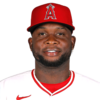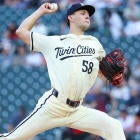White: 12 underrated players according ADP data
There is no such thing as a bad player, just a bad Fantasy player. On Thursday's episode of the Fantasy Baseball Today podcast, host Adam Aizer asked us if there was any player we absolutely wouldn't draft under any circumstances. Of course not!
Subscribe for free: iTunes | Stitcher
Every player is a value at some point. You may not like Andrew McCutchen or Ryan Braun or any other player, but if they fall far enough, every Fantasy player in the world would be happy to take them.
Conversely, even very good players can be bad Fantasy picks if you have to take them too high. And that's what this piece is about: the bad values. Specifically, the bad values early in your draft, those players going within the first 100 picks who just aren't going to provide a lot of value at their current prices. Here are my 12 most overdrafted players in Fantasy baseball with two weeks left until opening day.
All ADP numbers are from fantasypros.com.
It's possible we're overreacting to the news of the humidor in Arizona. His 162-game pace away from Chase Field in his career looks like this:
.298 average, 95 runs, 31 home runs, 112 RBI, 19 stolen bases
That's preeeeeetty good. If he does that this season, it would be hard to complain about him as a top-five pick. However, the concerns about Chase Field in the post-humidor world aren't just that it will no longer be a hitter's park, but that it might be one of the worst hitter's parks in baseball. In the two pitcher's parks he has spent the most time in (AT&T in San Francisco and Petco in San Diego), Goldschmidt's per-162 pace looks like this:
.284 average, 86 runs, 26 home runs, 98 RBI, 23 steals
That's still very, very good, of course, but it may be just a tick behind the kind of production you can get from Mookie Betts, Charlie Blackmon or Bryce Harper.
The truth is, we don't know what the impact of the humidor will be. Goldschmidt is by no means a product of Chase Field the way we've seen from some of the Rockies' best hitters in the past. But he is, like any player, influenced by the environment he plays in, and that environment could be a bad one for hitting. He's talented enough that the floor is still very high, but the changes at Chase certainly lower his chances of having elite upside, and that makes him just a bit of a reach at No. 5 overall.
I wrote about this earlier in the offseason, but it's time to stop paying the position premium. In Rotisserie leagues, Seager finished as the No. 67 hitter in 2017, after finishing 36th in 2016. In order to justify a No. 31 ADP, you've got to put an awful lot of weight on his position, in addition to expecting an improvement on his established level of play. It's not inconceivable that the supremely talented 23-year-old might improve, but it's hard to see him getting to 30-plus homers or even 10 stolen bases, and it's also awfully hard to break into the elite Fantasy discussion without doing either. He's good enough that he won't ruin your season here, but you're probably not going to get much return on your investment. At this draft price, you're paying for his ceiling.
Another place where positional scarcity seems to be pushing a player up, Jansen stands alone at the position, coming off the board 10 spots ahead of Craig Kimbrel and 15 spots ahead of Aroldis Chapman. He's exceptional, and a league context where starting pitchers are being counted on to throw ever fewer innings means his impact is even greater, but it's hard to justify nearly a third-round pick in someone who won't throw more than 70 innings.
With most of these players, it's not about not liking them. In Benintendi's case, I like him quite a bit. He could win a batting title before his career is out. He's got a great eye at the plate. He's a legitimate power-speed threat. But is he really worth this price? Here's just a sampling of some similar players going nearly a full round after him: Nelson Cruz (51), Christian Yelich (53) and Tommy Pham (57). All three were better than Benintendi last season, and while Pham and Cruz have some warts -- lack of track record and age -- both were significantly better in 2017. Yelich has a strong track record and now gets to move into an even better lineup and park in Milwaukee. Wait for someone to take Benintendi, and just snag Yelich with your next pick and get a better player.
Dallas Keuchel is a fine pitcher, but he's been feasting off that 2015 season ever since. While other pitchers get dinged for their lack of strikeouts or injury history, he has one season with more than 150 strikeouts, and hasn't even reached 170 innings in his past two seasons. And yet, there he is, a fifth-round pick in 12-team leagues. The ERA was pretty in 2016 when he posted a 2.90 mark, however that came with a 3.79 FIP that is above average, but certainly not worth this kind of investment. And lest you buy into the idea that Keuchel's groundball heavy approach makes him uniquely skilled in outperforming his peripherals, a 3.87 FIP came with a 4.55 ERA in 2016, and his career ERA is all of seven-hundredths of a point lower than his FIP. Keuchel is a fine pitcher, but he's not worth this price. I'll allow my wholesome Fantasy baseball meme to explain:
— ADP Boy (@CTowersCBS) March 14, 2018
Speaking of players still feasting off a big breakout three years ago, A.J. Pollock is here. And he's good! If you project out his 2017 numbers to 150 games, he would have been the No. 25 hitter, with a 150-game pace line of .266, 107 runs, 20 homers, 72 RBI and 29 stolen bases. As it is, he was the No. 111 hitter, and it's not like you can just project 150 games for him. Even before he missed 200 games over the last two seasons, Pollock had played more than 133 games exactly once as a professional, in that magical 2015. He has the ability to exceed this draft price, but there are few players as fragile, and you have to wonder if he's still really a 30-steal threat after multiple groin and quad injuries in recent years. Pollock isn't old, per se, but at 30, he's not young either. And, if the humidor pushes offense down in Arizona overall, those counting numbers are going to take a hit, too.
Now this is a nice price to pay for an elite reliever. But, are we sure Corey Knebel is one? He certainly looked the part a year ago, when he posted a 1.78 ERA with 126 strikeouts and 39 saves for the Brewers. He found some extra life on his fastball, which helped fuel a massive increase in his strikeout rate, but we've seen apparent one-year breakouts for relievers lead to disappointment. I'm not saying it won't stick, but he posted a 14.9 K/9 in 76 innings last season, but still gave up a ton of flyballs and walks. If that strikeout rate falls from elite to merely very, very good, he could return to being just the decent reliever he was before last season. This is an awfully high price to pay for the chance that his one good season was for real at a position with very little stability.
If you play in a league with daily lineup locks, you can mostly ignore this – though his struggles in spring training suggest he may not be quite ready to be an impact two-way player right away. That's the only league format where Ohtani can even come close to justifying this price. He isn't going to be in the lineup enough to be a weekly starter as a hitter, and the Angels' decision to go with a six-man rotation puts a hard cap on his value as a pitcher. If he stays healthy and starts one of every six games for the Angels, that gives him 27 starts as his max.
Even in the modern MLB, where 200-inning pitchers are rare and 250-inning aces are extinct, innings still matter. Ohtani is being taken as the No. 20 starting pitcher off the board, and last season, only six of the top-20 pitchers in Fantasy made 27 or fewer starts, and they were all either sub-3.00 ERA pitchers, or racked up 10-plus strikeouts per nine innings. In other words, they were all aces. Ohtani has that potential, but only two of the pitchers who made the top 20 without making more than 27 starts are being drafted ahead of him. Why invest in Ohtani when James Paxton is usually available at the same time and Rich Hill will still be on the board five or six rounds later?
If there is a theme here, it's to not pay full price for the one-year wonders, and Santana certainly fits that bill. There's no question Santana hits the snot out of the ball when he makes contact, as his 39.7 percent hard-hit rate in 2017 can attest. That was the 19th-highest mark in baseball, putting him in the company of guys like Jay Bruce and Manny Machado. However, even with his ability to smash the ball, his 30.9 percent HR/FB rate, which ranked third in the majors, probably wasn't sustainable. And, because Santana hits so few balls in the air – 27.7 percent flyball rate – even a small dip in his quality of contact could drop him to the 20-homer level. Add in potential batting average concerns thanks to his lofty strikeout rate, and there's a huge risk for a complete bust here. I don't dislike the talent, but he's a risky player, and the Brewers have options if he struggles. Just ask Jonathan Villar.
When we say the term "red flag," you probably envision something small. One of those flags you stick on the end of your car antenna, or a maybe a small hand towel to wave as a warning. Something understated.
With Miguel Sano, the red flag is about the size of one of the ones they use during NFL pregame ceremonies. And it's not just one. Miguel Sano: is coming off offseason surgery; has been described as having a "generous carriage" by team management; and is being investigated by MLB for an off-field incident that could leave him facing suspension. That he strikes out more than just about anyone not named Joey Gallo in the history of baseball hardly registers as a risk factor at this point, but yeah, that's still there too. Sano is an incredibly talented hitter, but there isn't a lot more upside here than what he showed in 2017 when he hit .264/.352/.507. That's a good hitter, but it's well short of elite, and the downside is staring you in the face. If it's 30-40 spots later, the upside starts to be worth it, but at this spot, you're paying for a ticking time bomb to blow up your roster.
I wrote last week about why Jose Berrios isn't worth the hype he's generating this offseason, and I don't want to repeat myself too much. But, his price is staying high, so it needs to be said again: Berrios is a good pitcher, but not good enough to justify this price. Even if we ignore his disastrous 2016 season – when he had an 8.02 ERA in 14 starts – Berrios didn't really show much star potential last season. Among 134 pitchers who threw at least 100 innings last season, he ranked 48th in ERA, 35th in FIP, 56th in SIERA, 61st in walk rate, 43rd in strikeout rate, 107th in groundball rate, and 80th in swinging strike rate. For the most part, he didn't realty stand out, for good or bad. Maybe the sum of the whole will be greater than the parts individually, but he hasn't really showed that ability yet. In spite of that, he's being drafted as the No. 25 starter off the board right now. There wasn't a big difference between Berrios last season and Jameson Taillon or Chase Anderson, both of whom are going 70-plus spots later in the draft than Berrios. Why pay the name-brand price just because he's a former top prospect?
You see it, right? Wood came out throwing fireballs early last season, with an average fastball velocity in his early starts 3-4 mph faster than last year's mark. That led to a 30.9 percent strikeout rate, 2.04 FIP and 1.67 ERA before the All-Star break, as he looked like he had legitimately taken a step forward. However, by the end of the season, his fastball was sitting in the low-90s, where it has always been, and his strikeout rate collapsed to 18.0 percent in the second half and his ERA ballooned to 3.89. By the end of the season, he looked an awful lot like the guy he was in 2015, the last time we saw Wood pitch a full season. Given his injury history and second-half decline, Wood is someone you should bet on in the 12th round – not the eighth.
![[object Object] Logo](https://sportshub.cbsistatic.com/i/2020/04/22/e9ceb731-8b3f-4c60-98fe-090ab66a2997/screen-shot-2020-04-22-at-11-04-56-am.png)



































